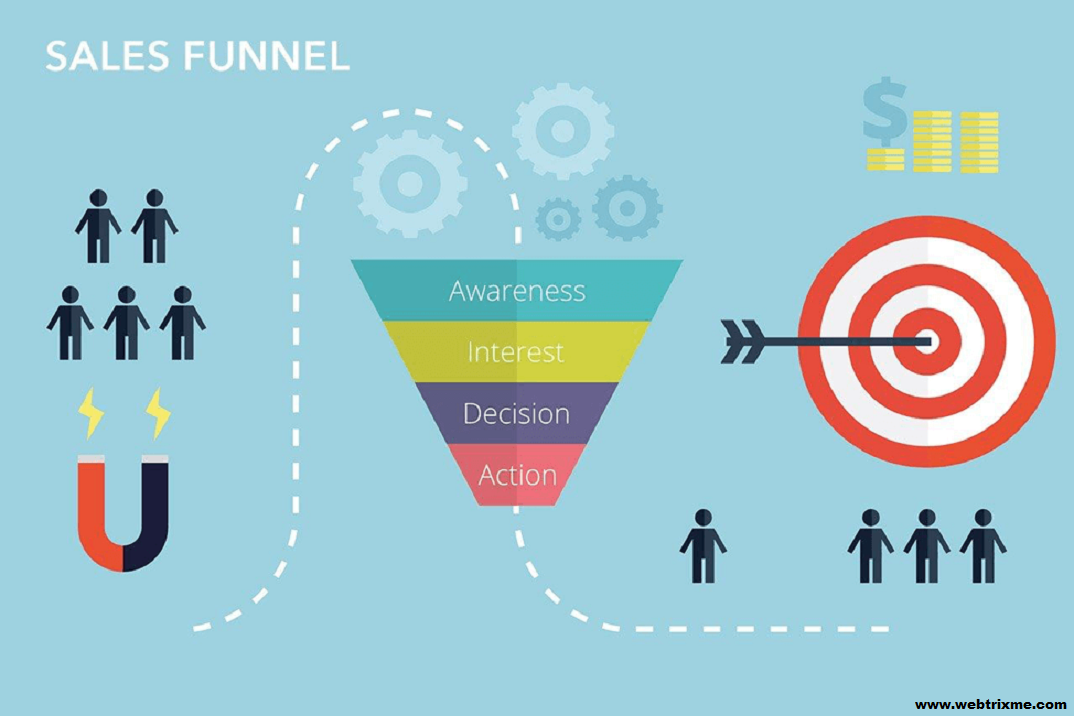Increasing sales is a challenge and an opportunity for businesses. The big challenge is to convert the sales leads into active customers. Effective sales funnel strategies realize this goal and guide leads to the bottom of the sales funnel. Digital sales strategies assist companies in reaching larger customers and creating a successful relationship with them.
Sales and marketing teams have to align to accomplish the common goal of sales funnel optimization. Sales optimization pushes high-prospect leads toward your website and drives revenue growth. However, sales optimization doesn’t guarantee conversions.
An effective communication and promotion strategies expand your digital sales funnel and push potential customers down to the sales funnel. A well-thought-out digital sales funnel guides customer’s journey from learning to purchasing. Effective sales funnel strategies influence buying decisions without active intervention. Sales funnel coordinated with marketing strategies to convert leads into long-term customers.
Analyse Your Customer Buyer Journey
Once you have evaluated your buyer persona, the sales funnel guides the buying journey and pushes qualified buyers from one stage to the next. It monitors the buyer’s journey, eliminates the roadblocks, and delivers the right information at the right moment. The marketing activities align with the funnel’s Top, Middle, and Bottom layers and work to maintain the flow from visitors to purchasers.
A well-planned sales funnel strategy observes how users progress from the awareness stage to the decision-making stage. It Identifies friction points in the buying journey from the first interaction up to becoming paying customers. Sales automation tools analyze multiple analytics data points and understand what engages your visitors best.
It creates customer journey maps throughout various touchpoints and analyzes customer buying journey experience at each step. It engages them with more content suggestions and delivers actionable results.
Define your Targeted Audience
Define your target audience clearly with in-depth demographic information like age, gender, location, profession, income, values, etc., and pitch them with an accurate content strategy. Knowledge of your target audiences is a vital aspect of the digital sales funnel to keep track of website conversions. Multiple visitors come to your page, but you aim to move forward with the ideal leads. The sales funnel optimization tool identifies your ideal customers at the top layer and attracts them down to the funnel.
Customers learn about the product from blogs, landing pages, ebooks, guides, and social media posts. To move down your top data to the sales pipeline, create interesting and engaging content like case studies, blogs, demos, and white papers to propose value in the buyer’s journey.
Meanwhile, the sales funnel evaluates and adjusts its strategies to minimize blockages and facilitate decision-making. The bottom of the sales funnel is the crucial stage, turning prospective leads into buyers.
Ease of Sales Process
Once you understand the engaging content your buyers need at each stage, you can handle prospects with meaningful content and optimize your sales strategies to make the information easy to process. An effective sales funnel allows companies to visualize each step of the buyer’s journey to build an easy sales process to minimize the pain points in the path to purchase.
Complex sales processes can cause frustration and irritation and significantly increase the drop-off rate of your potential customers. Make each sales funnel stage simple and painless to push high-quality leads down the funnel and minimize the likely drop-off rates.
Analyse Customers Looking Out
Improve Sales funnel efficiency at each stage of the buyer’s journey to convert the leads into opportunities. The prospective customers actively seek the solution that meets their budget and needs. They research multiple products of the same line, and your purpose is to add value to your product to stand out. The sales funnel analyzes the sequence of a buyer’s journey and demonstrates the product’s value at each stage. It breaks down the customer’s journey from awareness to interest to the last decision-making stage. The sales funnel goes narrow at each stage, and so do the leads. During the process, it eliminates the disqualified leads because they are not interested in buying. It filters out the right-fit customers and nurtures them through educational and engaging content. Effective sales funnel strategies build trust and rapport with the prospects and influence them to the funnel.
Personalise in Emails and Messaging Platforms
The digital sales funnel strengthens your online presence and delivers everything that confirms your work’s efficiency. Email nurturing is the essential aspect of digital sales funnel strategies to build a relationship and earn the trust of your prospective customers. With personalized and compelling content, you can direct your leads to join an email list.
The qualified email list can increase your conversion. You can communicate with your target audiences with relevant email messaging on special offers, season greetings, success tips, and so on to provide value and education. It’s a cost-effective way of marketing to grow brand awareness and trust. However, too many emails can be confusing and frustrating, so ensure that the email marketing company encourages leads to the next stage and does not cut off their journey in between.
Nurture Leads
At the top of the sales funnel, the critical task is anticipating the buyers’ needs and converting unqualified leads into qualified leads with a lead generation tool. Educate your ideal customers about the existing problems and explain how your solution, approach, and brand experience can meet their requirements. Search engine optimization and your website are effective mediums to increase traffic and expand your brand visibility. The lead nurturing job is started as you are exposed to the digital world.
Develop and reinforce relationships with your leads with engaging blog posts, social media content, and ebooks that address their pain points. Relevant content moves potential buyers through each sales funnel stage and accelerates conversion. Effective lead management strategy builds lasting relationships with qualified leads and guides them into sales.
Focus on Customer Retention
An effective sales strategy doesn’t end with the checkout process. It implements various tactics to measure customer loyalty over time and reduce churn rates. A customer retention policy increases your long-term revenue by turning one-time customers into repeated customers.
Strong onboarding experience, prompt help and support system customer feedback, shipping and return policy, newsletters, client testimonials, case studies, etc., are efficient ways to generate impact on your customers and gauge their overall experiences.
Memorable first impressions and personalized customer experiences advance customer relationships and enhance your company’s reputation and notability.
Social Identity
Your prospective leads belong to many social groups with distinct social identities. The sales funnel collects qualitative and quantitive data and segments your audiences in different categories so you can deliver relevant and helpful content.
The social identities of buyers play a crucial role in personalization and promotional tactics. You can determine your ideal customer and nurture them with targeted content.
Measure and Analyze Downfalls
Sales analytical tools are an indispensable resource for analyzing the traffic flow and measuring the number of traffic that turns into qualified leads. You can gauge the success rate and possible reasons for improvement at each stage to accelerate the sales process.
You can estimate the effectiveness of the sales funnel strategies by exploring website conversion, engagement from various sources of content, landing page submission rate, email click rate, and many more to identify successes and shortcomings.
The sales funnel tracks prospective customer journeys and measures customers’ volume, velocity, and conversion rates at every stage of the funnel. These funnel metrics help you to evaluate the performance and identify the risk areas.
Conclusion
The sales funnel is the convincing process from start to end. It collects marketing and sales funnel metrics, identifies pain points and opportunities, and adjusts sales funnel strategies accordingly.
The success of a sales funnel depends on how you structure the funnel to reach the quantifiable result with accuracy and speed.











+ There are no comments
Add yours